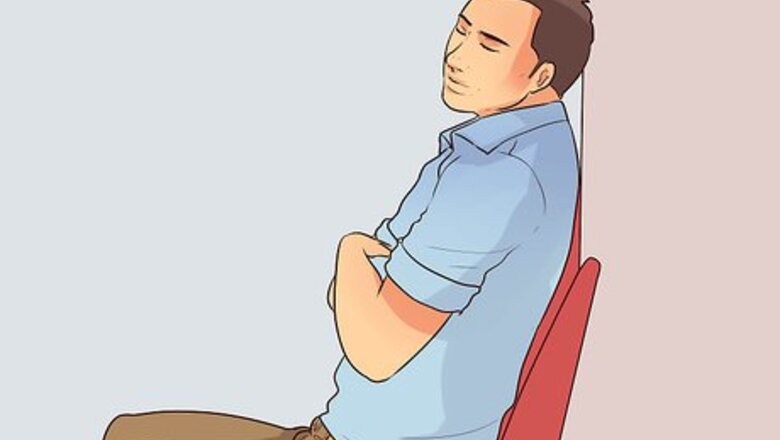
views
Getting Comfortable Without Your Bed
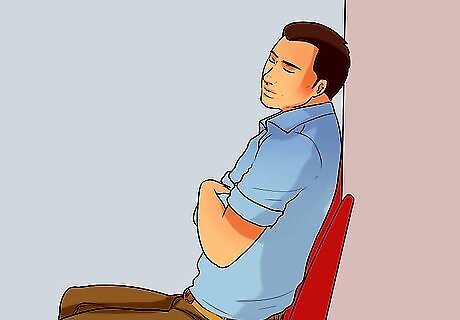
Find a place to lie down or sit in a relaxed posture. It can be hard to get comfortable to sleep when you don't have a bed to lie down in (at the airport, for instance). Sometimes there is simply no feasible place to lie down, so you may have to opt for a chair or sitting against a wall. If possible recline at a 135-degree angle for the most comfort. Avoid sleeping sitting straight up or leaning forward because this may cause undue pressure on your back and neck and it may also contribute to pain in those areas.
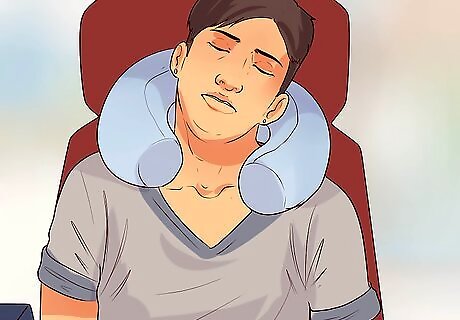
Use a pillow. A pillow helps make any unusual sleeping situation better. A travel pillow is best if you have to sit up while sleeping, such as on an airplane. If you're in an airport without a pillow, it might be time to splurge on a pillow at one of the travel shops. If you don't have a pillow, you can make one out of any clothing you have.
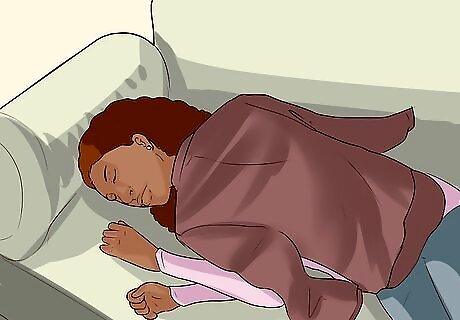
Cover up with a jacket as a blanket. Often, on short trips, or during unexpected waits (such as in an emergency room), you may not have thought to bring a blanket. If you have a jacket or coat, you can put it over you to provide extra heat. This will help you stay warm while trying to sleep.
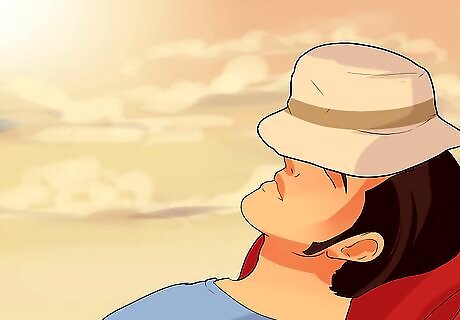
Use a small piece of fabric or a hat to cover your eyes. Or better yet, use a sleep mask. However, if you are caught unexpectedly needing to sleep without a bed, the likelihood is that you won't have a sleep mask on you. Don't worry, any lightweight, opaque fabric big enough to cover the eyes can help. This method works best if you are lying down or reclining. However, if you must sit, you may need to find something to drape over your head and face, such as a towel, that won't slide down.
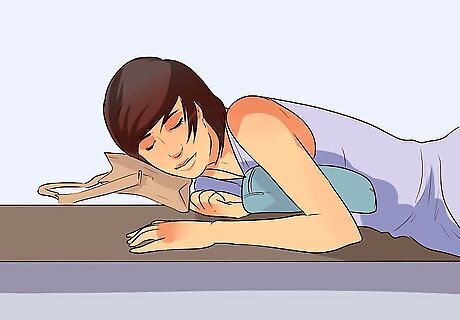
Secure your belongings if you are in a public place. If you really want to be able to sleep in a public place, you'll need to secure your belongings. Make sure small valuables are in pockets, or covered in your lap. For larger belongings, such as a duffle bag or suitcase, you may try keeping one foot down in the strap, or placing the luggage between your feet if it isn't too big. If you can plan ahead of time, you can put locks on the luggage. If you are lying down, you may want to use it as a pillow. Sometimes, airports have storage lockers you can use. If you are really worried about your belongings, consider this option when available. Never sleep in an area where you do not feel safe, especially if you are alone.
Sleeping in a Home Without an Extra Bed
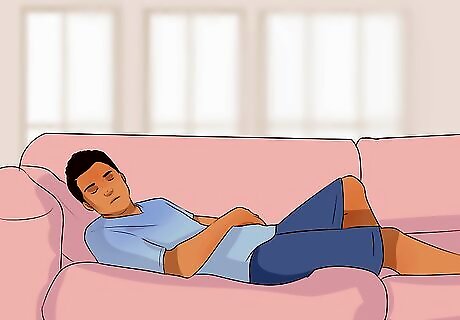
Sleep on a couch. If there is a couch available, this will often be the most comfortable option after a bed, as you will be able to stretch out. You'll want to make sure you have enough room to sleep comfortably, and you'll want to make sure your head isn't resting at an odd angle because of the couch's arm rests.
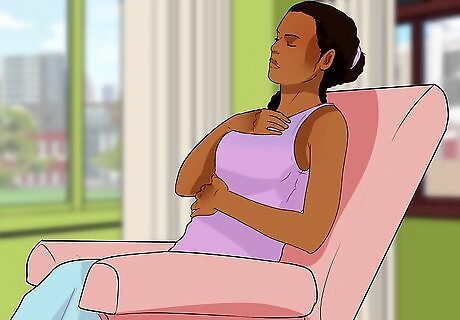
Sleep in a recliner. Recline at a 135-degree angle. Anywhere from 135 to 150 is highly recommended for easing back pain. Reclining at 135 degrees is also great for work, as it reduces stress on your back. Reclining 135 degrees is halfway between 90 degrees (sitting straight up) and 180 degrees (lying flat). >

Sleep on the floor. If the floor is carpeted, this can already be a cushy solution, especially if the couch isn't comfortable and there are no recliners. If not, try layering blankets to make the floor as comfy as possible. If you know beforehand that you'll be sleeping on the floor, bring your sleeping bag. Also, if the couch isn't quite comfortable because of armrests, you can try taking the cushions off the couch to make a makeshift bed.
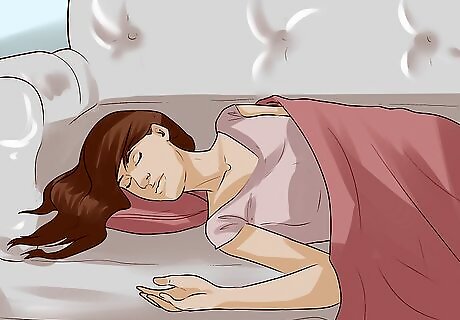
Make sure you have any necessary pillows or blankets. Just because you’re sleeping in a recliner or on the couch doesn’t mean you can’t have your favorite pillow or blanket to keep you comfortable. Depending on the recliner you may need additional cushion for neck and back support. If you plan to sleep in the recliner all night, having a blanket can make it feel more restful.
Sleeping Without a Bed While Camping
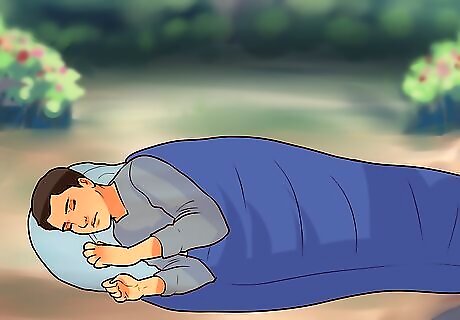
Use a sleeping bag. A sleeping bag is one of the best way to ensure you get the rest you need while camping. However there are some things to consider when choosing a sleeping bag, including the climate and forecast of the area where you're camping, whether you're hot- or cold-natured, and the amount of padding or waterproofing it provides. You don't want to be camping in a really cold or wet area without a sufficient sleeping bag. If you're planning a winter camping trip in a cold climate, make sure your sleeping bag is rated for the degree range you're going to be facing (-40 degrees, for instance). Some sleeping bags are rated for a lower temp than they'll actually stand up to, so it's best to choose a sleeping bag with a rating of at least 10 degrees below what you'll be facing. If you're camping in a really wet or rainy place, you'll want to make sure your sleeping bag and tent are waterproof, not just water-resistant. Water-resistant materials only keep out the water to a certain point. Waterproof materials should keep you dry. A sleeping bag with hydrophobic down is the best at keeping you warm in wet conditions. The "mummy-style" sleeping bag, or a sleeping bag that tapers at the end, is the best choice for staying warm, as it isn't as spacious as a rectangular sleeping bag, and thus is easier to keep warm with body heat.
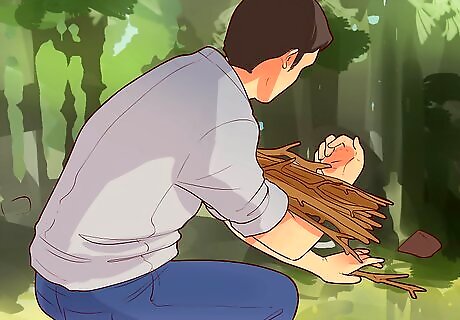
Remove sticks and other debris from the campsite. Sticks and stones can make for a very unpleasant sleep when camping. You'll want to go over the area carefully, and remove all debris. Even the tiniest twig or pebble can disturb some people's sleep. You may want to choose an area that is layered in pine needles for extra cushion.
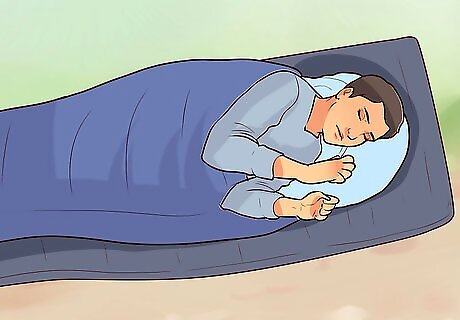
Provide cushioning or a cot for your sleeping bag. Cushioning such as sleeping mats or a cot can help you get good rest, as it will keep you from having to lie directly on the cold, hard ground. Sleeping platforms such as inflatable pads or foam pads often provide the support you need.
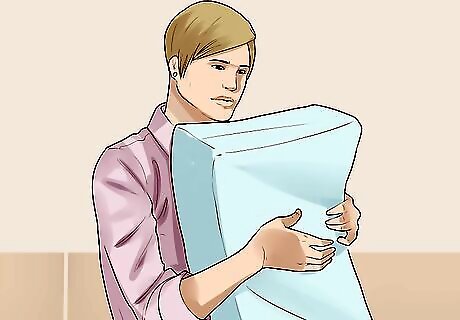
Don't forget a pillow. Using a pillow will help to keep your upper body in alignment when you are sleeping, and it may also help to prevent pain in your neck and back from undue pressure. A pillow will also help your sleeping bag feel closer to home and provide cushion and support for your neck and head while you sleep. With all the logistics that sometimes go into camping, it can be easy to forget your pillow, but if you want a good night's rest while camping, you'll have it on hand. If you do forget your pillow, try rolling up some clothing or other soft materials to use as a pillow.
Sleeping in a Hammock
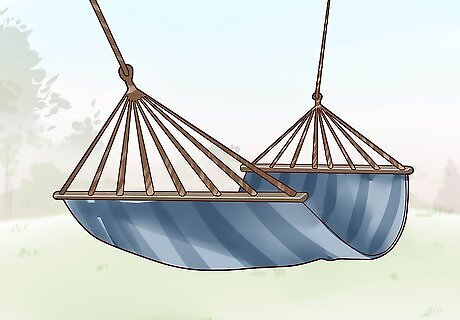
Choose a hammock that does not have spreader bars. Spreader bars make a hammock less stable and more likely to flip. A good hammock shouldn’t flip with you inside it. There are plenty of sturdier and more comfortable options available including nylon hammocks.
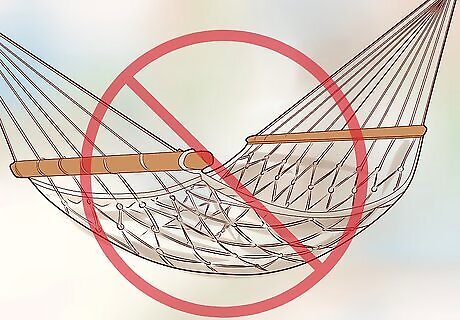
Avoid hammocks made of interlaced rope. Although this is traditional idea of a hammock, it is not very comfortable. As with any rope, it can chafe the skin. The longer you stay in a rope hammock, the less comfortable it will be.
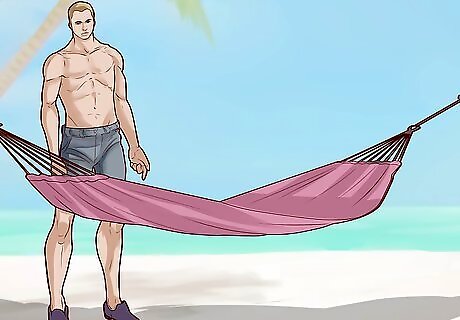
Choose a hammock based on your weight and height. You should choose a hammock that is four feet longer than your height. As for your weight, you should check the label to see what a hammock’s weight limits are. Using a hammock whose weight limit is less than your weight will make the hammock more likely to rip.
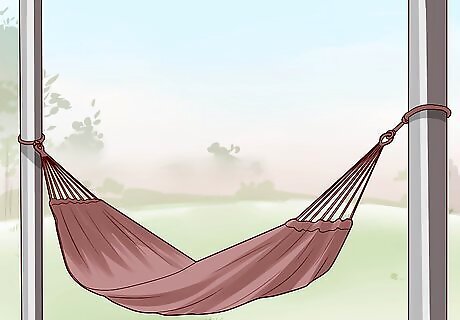
Hang the hammock from two points that are the same height. You need two sturdy points from which to hang the hammock. This can be two trees, two sturdy posts (that are correctly anchored), or a hammock stand. Keeping the hammock hang points even will make the hammock more comfortable, and you won’t find yourself in an awkward position when you get in.
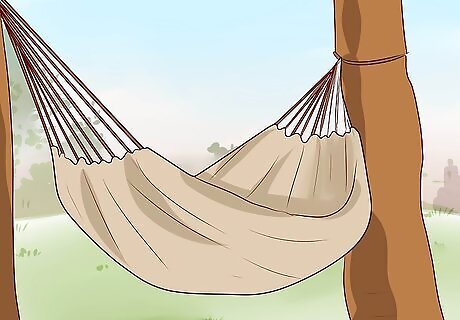
Let the hammock hang loosely. Don’t pull it tight. When you pull the hammock tight, it can be confining and uncomfortable. Letting it hang loose will make it more comfortable for sleeping. If it is too loose, you’ll know, as it will hit the ground when you’re lying in it.
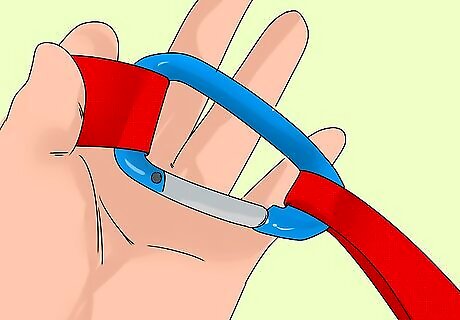
Inspect the hammock before you get into it. Make sure that the hammock is securely attached to sturdy supports and that it is not frayed or damaged in any way. Try pressing down on the hammock a few times to see if it feels sturdy before you get into it.
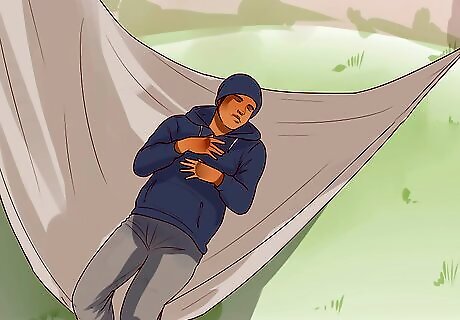
Lie in the middle of the hammock and shift your legs to one side until you are lying flat. Once you are at this angle, you should be able to rest easy for hours. This move will help you lay across the curve of the hammock rather than in it. This is the opposite of what happens when you pull the hammock too tight.
Starting a Routine of Sleeping on the Floor
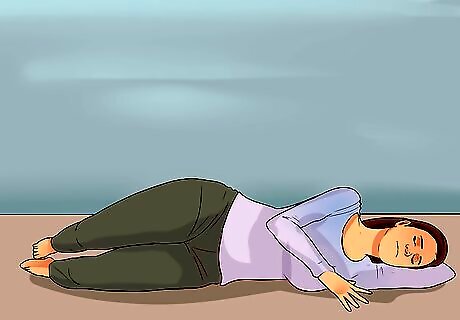
Try sleeping on the floor a few days before making up your mind about it. If you want to sleep on the floor as a lifestyle choice, then you might want to try it out a few times first. It takes time for your body to adjust to the new position and the absence of a soft mattress. You may be uncomfortable for the first few days, but after that you should get used to it. You may even wake up feeling refreshed once you’re in the routine of sleeping on the floor. In some cases, sleeping on the floor might be a necessity, such as if you do not have a bed.
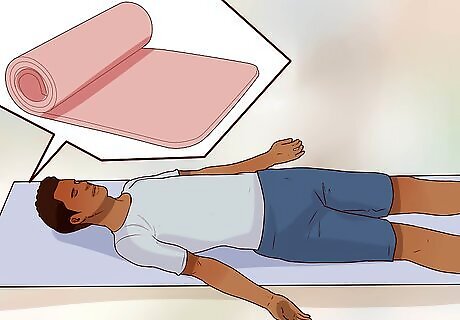
Use a yoga mat or other thing cushion between you and floor. In the beginning especially, you may want some type of cushion to help you transition from the bed to the floor. A yoga mat is great for this because it is already designed for you to lay down on at length and provides a slight cushion between you and the floor. You can also provide some cushioning for yourself by placing a few doubled up blankets on the floor.
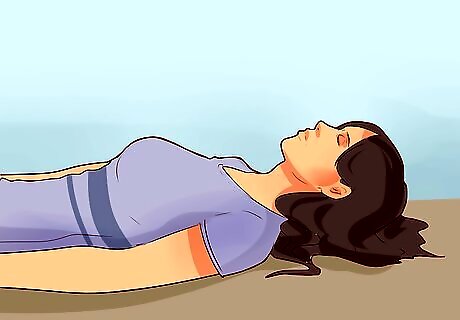
Sleep on your back. While you might have another preferred sleeping position when in bed, the best position for the floor is on your back. Otherwise, you won’t get the benefit of the back support the floor provides. Sleeping on your side while on the floor may cause back pain.
Starting a Routine of Sleeping Upright
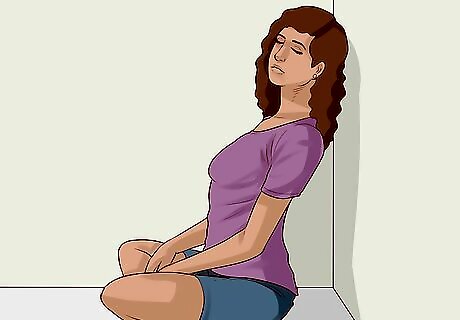
Start by sleeping against a surface at a slight angle. The angle should be slightly less than 90 degrees (70 is fine) to help you transition to sleeping fully upright. You can attain this angle by placing a board against the wall and stabilizing it or with a foam wedge (like those used in yoga or to raise the angle of your bed). The angle should be almost upright to get the closest to actually sleeping upright.
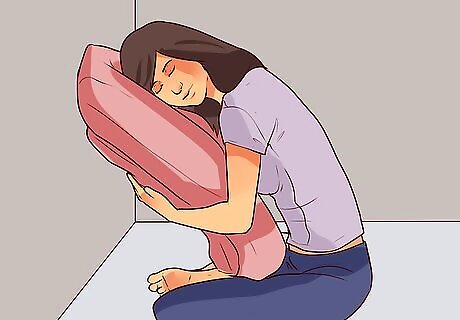
Use padding at first. When beginning to sleep upright, padding can ease the transition. This can be as simple as pillows and blankets. You can also use an extra-thick yoga mat and a pillow.
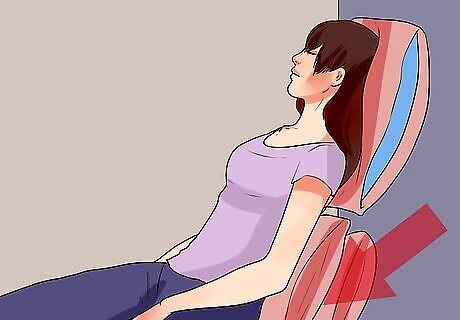
Make sure you have lower back support. You can use additional cushions or other back aids for this purpose. You need lower back support to sleep upright comfortably. It defeats the purpose of sleeping upright (to sleep with good posture) to avoid back support (until you can sleep upright without any support).
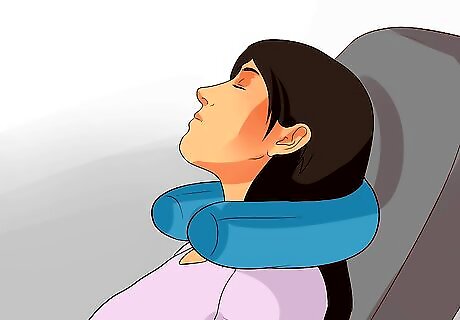
Use neck support. A J-pillow or a neck pillow will help your neck stay upright when you’re first learning to sleep upright. Without proper neck support you may find yourself dealing with severe neck pain when you wake up or a crick in your neck. Just make sure to keep your neck from slouching or leaning too much to one side.
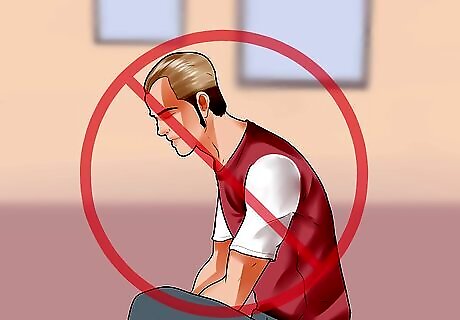
Avoid sleeping upright if you can’t get enough sleep doing it. More important than trying out a new position is making sure you’re getting enough rest. There are severe long-term health risks associated with not getting enough quality sleep. If sleeping upright just doesn’t seem to work after a few days, go back to your previous method of sleeping.
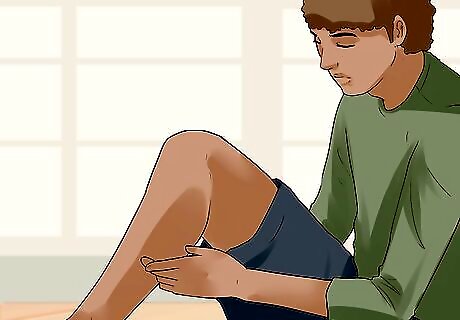
Be careful of deep-vein thrombosis (DVT). Although sleeping upright can be a rewarding experience for some, there are some risks involved, especially if you sleep for a long time with your legs bent. DVT is a serious and potentially life-threatening condition. It is the formation of a blood clot in one or more of the deep veins in your body, usually the legs. Sitting still for long periods of time is a risk factor for DVT. You can prevent a DVT by stretching legs and shifting positions every few hours.















Comments
0 comment